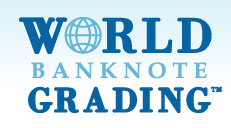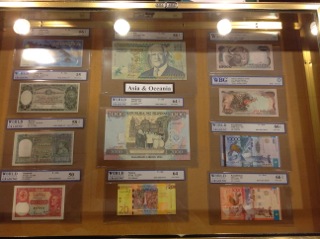 |
Home About FAQ's Contact |

How We Grade Paper Money World Banknote Grading™ company uses a painstakingly refined and modified Sheldon 70 Point Grading System to assign a reproducible and consistent final number to each note graded. Any additional relevant information is included on both the front and back of the label.
World Banknote Grading™ company uses a painstakingly refined and modified Sheldon 70 Point Grading System to assign a reproducible and consistent final number to each note graded. Any additional relevant information is included on both the front and back of the label.
If the explanation of the final grade is not clear, please contact us for clarification. We maintain grading documentation on every note for just that purpose. World Banknote Grading Scale and CriteriaUnder optimal conditions and with experience you should be able to ascertain the approximate grade range of a banknote yourself. World Banknote Grading can determine the exact grade, add the security of encapsulation, and as an independent third party we can provide grade legitimacy and transparency to currency collectors and dealers alike.UNCIRCULATED (UNC 70-60) Graded PaperIt can be especially difficult to determine the grade of high quality notes. Measurement, magnification, and excellent lighting conditions are optimal in determining the minute differences.In this grade range, World Banknote Grading is mainly looking at margins, registration, handling marks, corner tips, and corner folds. There can be no folds in the design area of the banknote.
ABOUT UNCIRCULATED (AU 58 Choice, AU 55, AU 53 & AU 50) Graded PaperOne or two folds can be in the design. The direction, location and degree of the fold(s) plus the level of handling determine the exact grade.EXTREMELY FINE (XF 45 Choice & XF 40) Graded PaperThree folds are commonly seen, with the exact grade depending on the type of fold and level of handling.VERY FINE (VF 35 Choice, VF 30, VF 25 & VF 20) Graded PaperUsually seen with several folds, the exact grade will depend on the extent of soiling, circulation and margin splits.FINE (FINE 15 Choice & FINE 12) Graded PaperExcessive folds are typical with the exact grade depending on the severity of the margin splits/tears. A small center split will drop the grade to a low FINE.VERY GOOD (VG 10 & VG 8) Graded PaperA lower but collectible grade that often shows limpness, rough edges and tears/splits in the design.GOOD (6 & 4), ABOUT GOOD (3), FAIR (2), and POOR (1) Graded PaperThese banknotes will show severe wear, missing portions of paper and other signs of deterioration. Rarity versus barely collectible grade - you decide.Definitions:
|
Paper Money Grading Services and Pricing
We have simplified the process and cost options for submitting your notes to be graded.Grading fees are as low as $25 per note, plus shipping.
Learn more about our grading services and pricing.
Submit your notes to World Banknote Grading.
Improved Banknote Identification and Attribution
World Banknote Grading adds more to its label than just country, denomination, date, serial number, catalog number, and grade.We also add exact dates if known, signature identification whenever possible, printer, and other specific characteristics beneficial to improved attribution.
To assist topical collectors, thematic information is also included on the back of each label.
We use an extensive reference collection of banknotes from almost 300 existing and obsolete countries as well as books, periodicals, and other research material to verify each note.
Direct comparisons with similar notes from a given country are utilized during the identification and grading process.
Learn more about how we grade banknotes.
©2013-2014 World Banknote Grading™
All rights reserved.